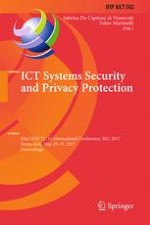This book constitutes the refereed proceedings of the 32nd IFIP TC 11 International Conference on ICT Systems Security and Privacy Protection, SEC 2017, held in Rome, Italy, in May 2017.
The 38 revised full papers presented were carefully reviewed and selected from 199 submissions. The papers are organized in the following topical sections: network security and cyber attacks; security and privacy in social applications and cyber attacks defense; private queries and aggregations; operating systems and firmware security; user authentication and policies; applied cryptography and voting schemes; software security and privacy; privacy; and digital signature, risk management, and code reuse attacks.
